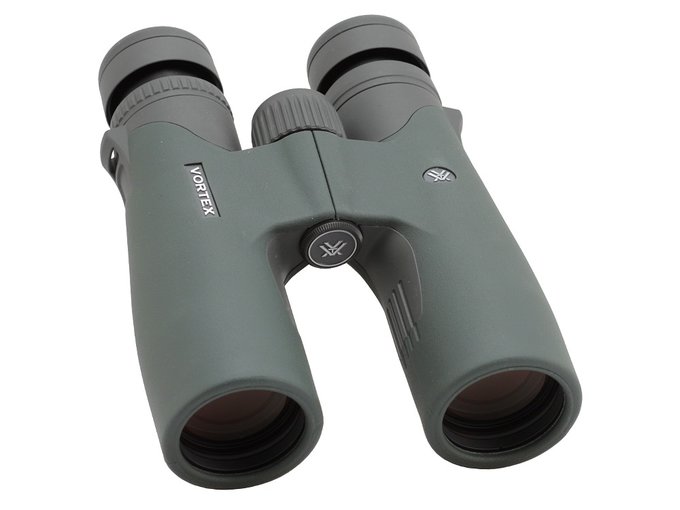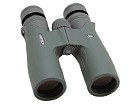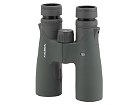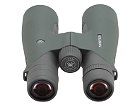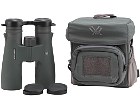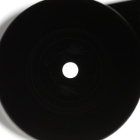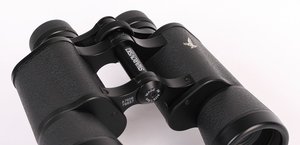Vortex Razor UHD 10x42
In 2019 Vortex took a very brave step and decided to attack the position of the biggest market players by launching the Razor UHD line which models are at a price point of 2000 USD.
 |
Of course you also get XR Plus Fully Multi-Coated layers on all air-to-glass surfaces. Additionally, you can find dielectric and phase-correction coatings on Abbe-Koenig prisms. It's not all. The outer elements feature ArmorTek hydrophobic coatings which task is to make them scratch-free and also dirt and oil resistant.
The chasis is made of durable magnesium composites and padded with good quality rubber armour which is supposed to stick to your hands well.
 |
| Magnification | Lens diameter | Angular field of view | Prisms | Eye relief | Weight | Price |
|---|---|---|---|---|---|---|
| 10 | 42 | 116/1000(6.6o) | BaK-4/roof | 16.7 mm | 913 g | 5879 PLN |
Summary
Pros:
- shapely, solid, and stylish chasis made of magnesium composites,
- significant field of view,
- excellent correction of astigmatism,
- very low chromatic aberration in the centre of field of view,
- very good coma correction,
- low brightness loss on the edge of the field,
- sharp image up to almost 90% of the field,
- very good colour rendering,
- high quality coatings,
- good quality prisms made of BaK-4 glass,
- minimum focusing distance from already 1.45 metres,
- lifetime warranty,
- very dark areas next to exit pupils,
- proper performance against bright light,
- excellent darkening and cleanliness inside the tubes.
Wady:
- big physical dimensions and significant weight for the 42 mm class.
 |
Still the best market producers also offer something for less affluent customers – practically all of them have in their line-up models which are optically excellent but priced aroud 1000-1500 USD. In the case of Leica you get the Trinovid HD series, Nikon offers you the Monarch HG, Swarovski – Porro prism Habichts and the SLC W B, and Zeiss – the Conquest HD series.
That last group of binoculars has been the target of the Vortex company for some time now, as they were offering the Razor HD series. So far, we have tested the 10x42 model and we said a lot of positive things about it. When Vortex announced an even more expensive Razor UHD series I was intrigued and I wanted to check any of these binoculars in practice in order to find out whether they stand a chance to compete with of any the biggest market leaders.
Still it must be mentioned that, at least in Poland, there is a healthy gap in prices between the newest Vortex flagship models and those produced by the market leaders. In case of the Vortex binoculars you don't have to spend 8000-11000 PLN, it's enough you pay a bit less than 6000 PLN. When you compare that to prices in the Western Europe or in the USA it might seem a kind of a bargain – in these countries the Razor UHD 10x42 costs you about 2000 USD (equivalent of about 8000-9000 PLN).
 Vortex Diamondback HD 10x42 and Vortex Razor UHD 10x42. |
I think Vortex learned that lesson with the Viper HD and Razor HD. We tested their respective 10x42 models and the second one was just slightly better than the first one; still the price difference between them is significant. Will it be also true in the case of the Razor HD and UHD? Let's check it up!
Without beating about the bush we might say that the premium segment attack, performed by Vortex, proved to be quite efficient. Of course the very top of the range, so the Swarovision EL, the Victory SF and the Nikon EDG, still remains out of its reach but the Razor UHD is as good as, or sometimes even better than, the Ultravid HD+, the Monarch HG, the SLC W B, the Conquest HD, or the Victory HT. It's still no mean feat.
Apart from that even a casual handling of the Razor UHD reveals what type of equipment you're dealing with. The binoculars look really great – personally I think the designers really did a great job because, in my opinion, all Vortex models are the prettiest pairs of binoculars, available on the market. I don't mean here just the most expensive flagship devices because even these Diamondbacks HD look really great.
Anyway, when you handle the Razor UHD the first thing that sticks out is the excellent build quality. The binoculars are a joy to use, very comfortable to look through and to carry around. Even a detailed inspeciton doesn't reveal any slip-ups. Everything fits perfectly well, without any glitches, the interior of the tubes is clean and perfectly blackened. What's more, the binoculars' parameters are exactly as stated by the producers in official specifications.
Is there any fly in that ointment? We still noticed some problems. Firstly, the complexity of the optics which adversely affects transmission.
 |
Weight and physical dimensions are the second important factor. Indeed, it's also my most serious reservation concerning the tested binoculars. I think there are many 10x50 models on the market with physical dimensions and weight similar to those of the Razor UHD – in order not to sound groundless let's have a look at the following chart. All premium class binoculars in this group are smaller and lighter than the Vortex product. What's more, they also come with a better eye relief distance. The assets of the Vortex are a good field of view (only narrower than that of the Victory SF), and a minimum focusing distance, along, of course, with a noticeably lower price.
Still physical dimensions and weight cannot be hidden and, I suppose, it's an advantage – you get them stated clearly in official specifications and it's up to you to decide whether you can accept them or not. If you want to have a premium pair of binoculars for a price significantly lower than the prices of the Leica, the Nikons, the Swarovskis and the Zeiss you might find the Viper UHD a good compromise
Still, another important question remains: is the price difference between the Razor HD and the Razor UHD justifiable? The results of our test might suggest that it is not but the test doesn't reflect build quality and how the binoculars will perform after several years of wear and tear. I think it's sensible to assume that the more expensive Razor UHD, produced in Japan, will be able to withstand more than China-produced Viper HD and Razor HD models. Such things are always worth consideration.
In my view Vortex complemented their line-up in a great way and now their series of binoculars include all price-points so the customers have a wide selection of devices no matter how much they are able to or want to spend. What's more, at each price point Vortex offers you really good, solid instruments which compare very favourably with their direct rivals, produced by other manufacturers.





